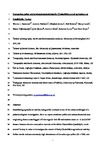Comparing pollen and archaeobotanical data for Chalcolithic cereal agriculture at Çatalhöyük, Turkey
| dc.contributor.author | Eastwood, WJ | |
| dc.contributor.author | Fairbairn, A | |
| dc.contributor.author | Stroud, E | |
| dc.contributor.author | Roberts, C Neil | |
| dc.contributor.author | Lamb, H | |
| dc.contributor.author | Yiğitbaşıoğlu, H | |
| dc.contributor.author | Şenkul, Ç | |
| dc.contributor.author | Moss, A | |
| dc.contributor.author | Turner, Rebecca | |
| dc.contributor.author | Boyer, P | |
| dc.date.accessioned | 2019-01-15T13:29:12Z | |
| dc.date.available | 2019-01-15T13:29:12Z | |
| dc.date.issued | 2018-12-15 | |
| dc.identifier.issn | 0277-3791 | |
| dc.identifier.uri | http://hdl.handle.net/10026.1/13139 | |
| dc.description.abstract |
© 2018 Establishing agricultural activity using pollen analysis is one of the prime challenges of a palaeoecological investigation. Here we report combined pollen and archaeobotanical data originating from a waterlogged off-site organic-rich fill radiocarbon dated to ∼8 ka Cal BP located between the two occupation mounds at Neolithic-Chalcolithic Çatalhöyük, south central Turkey in order to investigate the record of Early Chalcolithic agricultural activity. Pollen results indicate extremely high abundances of Cerealia-type pollen (30->70%) and critical measurements of these show them to be Triticum-type, Avena/Triticum-type, Secale-type and Hordeum-type. Pollen data are also compared with archaeobotanical data retrieved from the same sediment matrix and show high abundances of Triticum and Hordeum grains, awns, spikelet forks and glume bases. Archaeobotanical and pollen data are therefore unequivocal in showing the presence of cereals throughout the period of deposition, and although preservation of archaeobotanical cereal plant remains is typically poor, the presence of glume wheats, including emmer/‘New Type’ wheat and domesticated barley, is consistent with cereal data from on-site excavation deposits at Çatalhöyük. Pollen data also include high occurrences of clusters of Cerealia-type, Chenopodiaceae, Poaceae and Asteraceae and point to local deposition that is best explained as the anthers being deposited at the coring site attached to cereal or other herbaceous waste material. Archaeobotanical data in addition to very high percentage values of individual Cerealia-type pollen grains and clusters of Cerealia-type pollen and other non-arboreal pollen types suggest that the margins of the Çatalhöyük site were probably used for early stage crop processing activities as well as a waste site. Although radiocarbon dating of this organic-rich fill suggests that it was deposited over a very short time period (∼300 years) during the Early Chalcolithic, the data highlight the importance of adopting complementary palynological and archaeobotanical approaches in order to better understand the taphonomy of micro and macrofossil deposits associated with archaeological sites. While more distant, regional pollen sites in south-central Anatolia have difficulty registering Neolithic-Chalcolithic cereal cultivation, this study shows that if a pollen core site is located too close to an archaeological site, then pollen assemblages can be overwhelmed and ‘swamped’ by the products of local cereal processing and the inclusion of domestic waste material thus rendering it difficult to elucidate meaningful data on local agricultural activity. | |
| dc.format.extent | 4-18 | |
| dc.language | en | |
| dc.language.iso | en | |
| dc.publisher | Elsevier | |
| dc.subject | Catalhoyuk | |
| dc.subject | Cereal pollen | |
| dc.subject | Archaeobotany | |
| dc.subject | Chalcolithic | |
| dc.subject | Neolithic | |
| dc.subject | Agriculture | |
| dc.subject | Turkey | |
| dc.title | Comparing pollen and archaeobotanical data for Chalcolithic cereal agriculture at Çatalhöyük, Turkey | |
| dc.type | journal-article | |
| dc.type | Journal Article | |
| plymouth.author-url | https://www.webofscience.com/api/gateway?GWVersion=2&SrcApp=PARTNER_APP&SrcAuth=LinksAMR&KeyUT=WOS:000454965500002&DestLinkType=FullRecord&DestApp=ALL_WOS&UsrCustomerID=11bb513d99f797142bcfeffcc58ea008 | |
| plymouth.volume | 202 | |
| plymouth.publication-status | Published | |
| plymouth.journal | Quaternary Science Reviews | |
| dc.identifier.doi | 10.1016/j.quascirev.2018.11.012 | |
| plymouth.organisational-group | /Plymouth | |
| plymouth.organisational-group | /Plymouth/Faculty of Science and Engineering | |
| plymouth.organisational-group | /Plymouth/PS - Library and Educational Development | |
| plymouth.organisational-group | /Plymouth/REF 2021 Researchers by UoA | |
| plymouth.organisational-group | /Plymouth/REF 2021 Researchers by UoA/UoA23 Education | |
| plymouth.organisational-group | /Plymouth/Research Groups | |
| plymouth.organisational-group | /Plymouth/Research Groups/Marine Institute | |
| plymouth.organisational-group | /Plymouth/Users by role | |
| plymouth.organisational-group | /Plymouth/Users by role/Academics | |
| dcterms.dateAccepted | 2018-11-09 | |
| dc.rights.embargodate | 2019-11-23 | |
| dc.rights.embargoperiod | Not known | |
| rioxxterms.versionofrecord | 10.1016/j.quascirev.2018.11.012 | |
| rioxxterms.licenseref.uri | http://www.rioxx.net/licenses/all-rights-reserved | |
| rioxxterms.licenseref.startdate | 2018-12-15 | |
| rioxxterms.type | Journal Article/Review |


